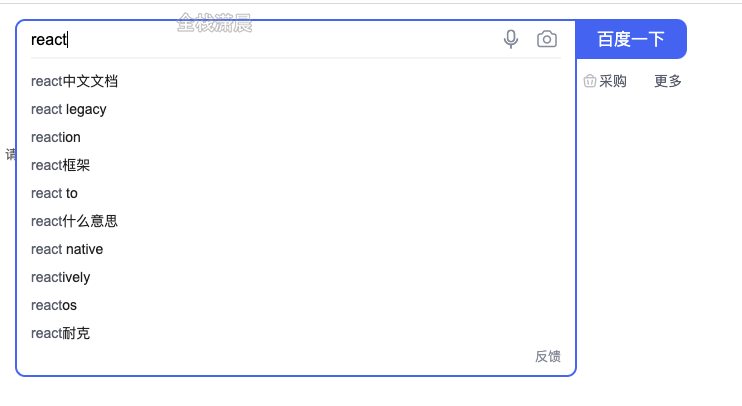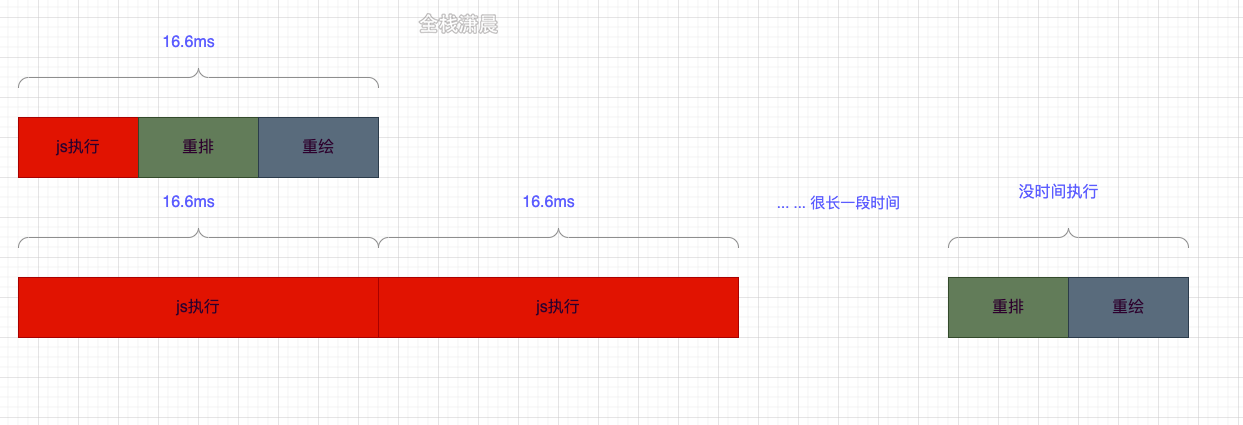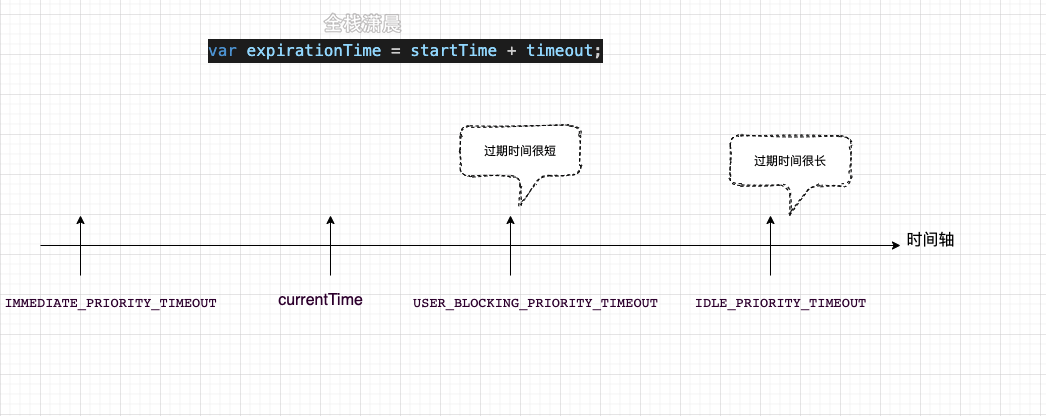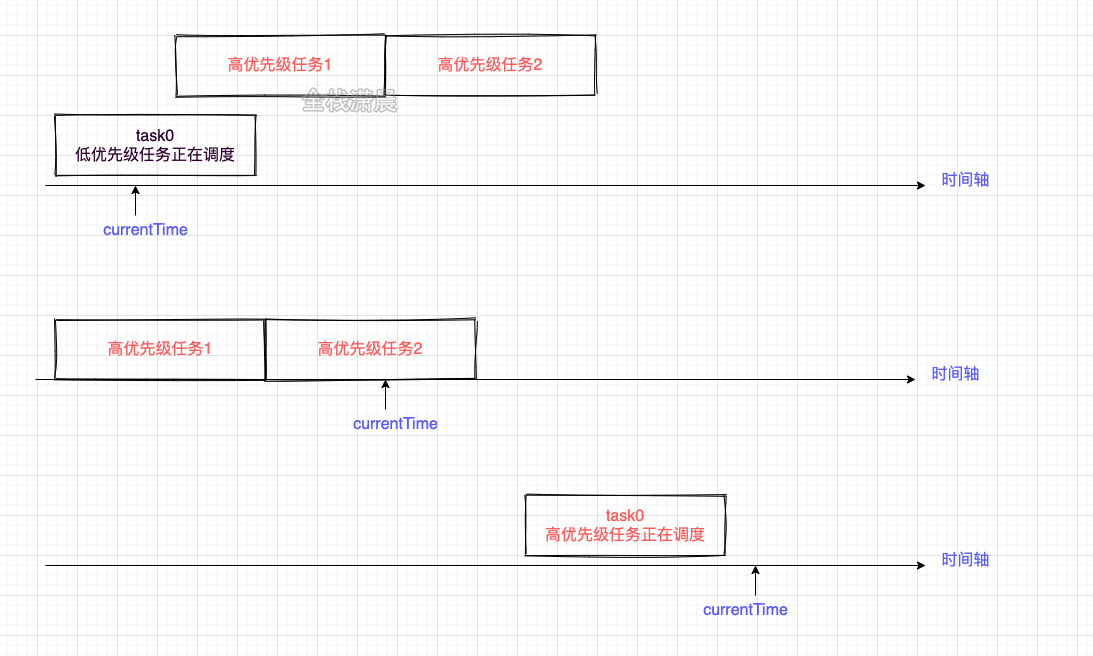react 源码解析 15.scheduler&Lane
视频课程(高效学习):进入课程
课程目录:
1.开篇介绍和面试题
2.react的设计理念
3.react源码架构
4.源码目录结构和调试
5.jsx&核心api
6.legacy和concurrent模式入口函数
7.Fiber架构
8.render阶段
9.diff算法
10.commit阶段
11.生命周期
12.状态更新流程
13.hooks源码
14.手写hooks
15.scheduler&Lane
16.concurrent模式
17.context
18事件系统
19.手写迷你版react
20.总结&第一章的面试题解答
21.demo
当我们在类似下面的搜索框组件进行搜索时会发现,组件分为搜索部分和搜索结果展示列表,我们期望输入框能立刻响应,结果列表可以有等待的时间,如果结果列表数据量很大,在进行渲染的时候,我们又输入了一些文字,因为用户输入事件的优先级是很高的,所以就要停止结果列表的渲染,这就引出了不同任务之间的优先级和调度
Scheduler
我们知道如果我们的应用占用较长的 js 执行时间,比如超过了设备一帧的时间,那么设备的绘制就会出不的现象。
Scheduler 主要的功能是时间切片和调度优先级,react 在对比差异的时候会占用一定的 js 执行时间,Scheduler 内部借助 MessageChannel 实现了在浏览器绘制之前指定一个时间片,如果 react 在指定时间内没对比完,Scheduler 就会强制交出执行权给浏览器
时间切片
在浏览器的一帧中 js 的执行时间如下
requestIdleCallback 是在浏览器重绘重排之后,如果还有空闲就可以执行的时机,所以为了不影响重绘重排,可以在浏览器在 requestIdleCallback 中执行耗性能的计算,但是由于 requestIdleCallback 存在兼容和触发时机不稳定的问题,scheduler 中采用 MessageChannel 来实现 requestIdleCallback,当前环境不支持 MessageChannel 就采用 setTimeout。
在之前的介绍中我们知道在 performUnitOfWork 之后会执行 render 阶段和 commit 阶段,如果在浏览器的一帧中,cup 的计算还没完成,就会让出 js 执行权给浏览器,这个判断在 workLoopConcurrent 函数中,shouldYield 就是用来判断剩余的时间有没有用尽。在源码中每个时间片时 5ms,这个值会根据设备的 fps 调整。
function workLoopConcurrent() { while (workInProgress !== null && !shouldYield()) { performUnitOfWork(workInProgress); }}
复制代码
function forceFrameRate(fps) {//计算时间片 if (fps < 0 || fps > 125) { console['error']( 'forceFrameRate takes a positive int between 0 and 125, ' + 'forcing frame rates higher than 125 fps is not supported', ); return; } if (fps > 0) { yieldInterval = Math.floor(1000 / fps); } else { yieldInterval = 5;//时间片默认5ms }}
复制代码
任务的暂停
在 shouldYield 函数中有一段,所以可以知道,如果当前时间大于任务开始的时间+yieldInterval,就打断了任务的进行。
//deadline = currentTime + yieldInterval,deadline是在performWorkUntilDeadline函数中计算出来的if (currentTime >= deadline) { //... return true}
复制代码
调度优先级
在 Scheduler 中有两个函数可以创建具有优先级的任务
function unstable_runWithPriority(priorityLevel, eventHandler) { switch (priorityLevel) {//5种优先级 case ImmediatePriority: case UserBlockingPriority: case NormalPriority: case LowPriority: case IdlePriority: break; default: priorityLevel = NormalPriority; } var previousPriorityLevel = currentPriorityLevel;//保存当前的优先级 currentPriorityLevel = priorityLevel;//priorityLevel赋值给currentPriorityLevel try { return eventHandler();//回调函数 } finally { currentPriorityLevel = previousPriorityLevel;//还原之前的优先级 } }
复制代码
scheduleCallback:以一个优先级注册 callback,在适当的时机执行,因为涉及过期时间的计算,所以 scheduleCallback 比 runWithPriority 的粒度更细。
在 scheduleCallback 中优先级意味着过期时间,优先级越高 priorityLevel 就越小,过期时间离当前时间就越近,var expirationTime = startTime + timeout;例如 IMMEDIATE_PRIORITY_TIMEOUT=-1,那var expirationTime = startTime + (-1);就小于当前时间了,所以要立即执行。
scheduleCallback 调度的过程用到了小顶堆,所以我们可以在 O(1)的复杂度找到优先级最高的 task,不了解可以查阅资料,在源码中小顶堆存放着任务,每次 peek 都能取到离过期时间最近的 task。
scheduleCallback 中,未过期任务 task 存放在 timerQueue 中,过期任务存放在 taskQueue 中。
新建 newTask 任务之后,判断 newTask 是否过期,没过期就加入 timerQueue 中,如果此时 taskQueue 中还没有过期任务,timerQueue 中离过期时间最近的 task 正好是 newTask,则设置个定时器,到了过期时间就加入 taskQueue 中。
当 timerQueue 中有任务,就取出最早过期的任务执行。
function unstable_scheduleCallback(priorityLevel, callback, options) { var currentTime = getCurrentTime();
var startTime;//开始时间 if (typeof options === 'object' && options !== null) { var delay = options.delay; if (typeof delay === 'number' && delay > 0) { startTime = currentTime + delay; } else { startTime = currentTime; } } else { startTime = currentTime; }
var timeout; switch (priorityLevel) { case ImmediatePriority://优先级越高timeout越小 timeout = IMMEDIATE_PRIORITY_TIMEOUT;//-1 break; case UserBlockingPriority: timeout = USER_BLOCKING_PRIORITY_TIMEOUT;//250 break; case IdlePriority: timeout = IDLE_PRIORITY_TIMEOUT; break; case LowPriority: timeout = LOW_PRIORITY_TIMEOUT; break; case NormalPriority: default: timeout = NORMAL_PRIORITY_TIMEOUT; break; }
var expirationTime = startTime + timeout;//优先级越高 过期时间越小
var newTask = {//新建task id: taskIdCounter++, callback//回调函数 priorityLevel, startTime,//开始时间 expirationTime,//过期时间 sortIndex: -1, }; if (enableProfiling) { newTask.isQueued = false; }
if (startTime > currentTime) {//没有过期 newTask.sortIndex = startTime; push(timerQueue, newTask);//加入timerQueue //taskQueue中还没有过期任务,timerQueue中离过期时间最近的task正好是newTask if (peek(taskQueue) === null && newTask === peek(timerQueue)) { if (isHostTimeoutScheduled) { cancelHostTimeout(); } else { isHostTimeoutScheduled = true; } //定时器,到了过期时间就加入taskQueue中 requestHostTimeout(handleTimeout, startTime - currentTime); } } else { newTask.sortIndex = expirationTime; push(taskQueue, newTask);//加入taskQueue if (enableProfiling) { markTaskStart(newTask, currentTime); newTask.isQueued = true; } if (!isHostCallbackScheduled && !isPerformingWork) { isHostCallbackScheduled = true; requestHostCallback(flushWork);//执行过期的任务 } }
return newTask;}
复制代码
任务暂停之后怎么继续
在 workLoop 函数中有这样一段
const continuationCallback = callback(didUserCallbackTimeout);//callback就是调度的callbackcurrentTime = getCurrentTime();if (typeof continuationCallback === 'function') {//判断callback执行之后的返回值类型 currentTask.callback = continuationCallback;//如果是function类型就把又赋值给currentTask.callback markTaskYield(currentTask, currentTime);} else { if (enableProfiling) { markTaskCompleted(currentTask, currentTime); currentTask.isQueued = false; } if (currentTask === peek(taskQueue)) { pop(taskQueue);//如果是function类型就从taskQueue中删除 }}advanceTimers(currentTime);
复制代码
在 performConcurrentWorkOnRoot 函数的结尾有这样一个判断,如果 callbackNode 等于 originalCallbackNode 那就恢复任务的执行
if (root.callbackNode === originalCallbackNode) { // The task node scheduled for this root is the same one that's // currently executed. Need to return a continuation. return performConcurrentWorkOnRoot.bind(null, root);}
复制代码
Lane
Lane 的和 Scheduler 是两套优先级机制,相比来说 Lane 的优先级粒度更细,Lane 的意思是车道,类似赛车一样,在 task 获取优先级时,总是会优先抢内圈的赛道,Lane 表示的优先级有以下几个特点。
export const NoLanes: Lanes = /* */ 0b0000000000000000000000000000000; export const NoLane: Lane = /* */ 0b0000000000000000000000000000000; export const SyncLane: Lane = /* */ 0b0000000000000000000000000000001; export const SyncBatchedLane: Lane = /* */ 0b0000000000000000000000000000010; export const InputDiscreteHydrationLane: Lane = /* */ 0b0000000000000000000000000000100; const InputDiscreteLanes: Lanes = /* */ 0b0000000000000000000000000011000; const InputContinuousHydrationLane: Lane = /* */ 0b0000000000000000000000000100000; const InputContinuousLanes: Lanes = /* */ 0b0000000000000000000000011000000; export const DefaultHydrationLane: Lane = /* */ 0b0000000000000000000000100000000; export const DefaultLanes: Lanes = /* */ 0b0000000000000000000111000000000; const TransitionHydrationLane: Lane = /* */ 0b0000000000000000001000000000000; const TransitionLanes: Lanes = /* */ 0b0000000001111111110000000000000; const RetryLanes: Lanes = /* */ 0b0000011110000000000000000000000; export const SomeRetryLane: Lanes = /* */ 0b0000010000000000000000000000000; export const SelectiveHydrationLane: Lane = /* */ 0b0000100000000000000000000000000; const NonIdleLanes = /* */ 0b0000111111111111111111111111111; export const IdleHydrationLane: Lane = /* */ 0b0001000000000000000000000000000; const IdleLanes: Lanes = /* */ 0b0110000000000000000000000000000; export const OffscreenLane: Lane = /* */ 0b1000000000000000000000000000000;
复制代码
export function includesSomeLane(a: Lanes | Lane, b: Lanes | Lane) { return (a & b) !== NoLanes; }
复制代码
Lane 模型中 task 是怎么获取优先级的(赛车的初始赛道)
任务获取赛道的方式是从高优先级的 lanes 开始的,这个过程发生在 findUpdateLane 函数中,如果高优先级没有可用的 lane 了就下降到优先级低的 lanes 中寻找,其中 pickArbitraryLane 会调用 getHighestPriorityLane 获取一批 lanes 中优先级最高的那一位,也就是通过lanes & -lanes获取最右边的一位
export function findUpdateLane( lanePriority: LanePriority, wipLanes: Lanes,): Lane { switch (lanePriority) { //... case DefaultLanePriority: { let lane = pickArbitraryLane(DefaultLanes & ~wipLanes);//找到下一个优先级最高的lane if (lane === NoLane) {//上一个level的lane都占满了下降到TransitionLanes继续寻找可用的赛道 lane = pickArbitraryLane(TransitionLanes & ~wipLanes); if (lane === NoLane) {//TransitionLanes也满了 lane = pickArbitraryLane(DefaultLanes);//从DefaultLanes开始找 } } return lane; } }}
复制代码
Lane 模型中高优先级是怎么插队的(赛车抢赛道)
在 Lane 模型中如果一个低优先级的任务执行,并且还在调度的时候触发了一个高优先级的任务,则高优先级的任务打断低优先级任务,此时应该先取消低优先级的任务,因为此时低优先级的任务可能已经进行了一段时间,Fiber 树已经构建了一部分,所以需要将 Fiber 树还原,这个过程发生在函数 prepareFreshStack 中,在这个函数中会初始化已经构建的 Fiber 树
function ensureRootIsScheduled(root: FiberRoot, currentTime: number) { const existingCallbackNode = root.callbackNode;//之前已经调用过的setState的回调 //... if (existingCallbackNode !== null) { const existingCallbackPriority = root.callbackPriority; //新的setState的回调和之前setState的回调优先级相等 则进入batchedUpdate的逻辑 if (existingCallbackPriority === newCallbackPriority) { return; } //两个回调优先级不一致,则被高优先级任务打断,先取消当前低优先级的任务 cancelCallback(existingCallbackNode); } //调度render阶段的起点 newCallbackNode = scheduleCallback( schedulerPriorityLevel, performConcurrentWorkOnRoot.bind(null, root), ); //...}
复制代码
function prepareFreshStack(root: FiberRoot, lanes: Lanes) { root.finishedWork = null; root.finishedLanes = NoLanes; //... //workInProgressRoot等变量重新赋值和初始化 workInProgressRoot = root; workInProgress = createWorkInProgress(root.current, null); workInProgressRootRenderLanes = subtreeRenderLanes = workInProgressRootIncludedLanes = lanes; workInProgressRootExitStatus = RootIncomplete; workInProgressRootFatalError = null; workInProgressRootSkippedLanes = NoLanes; workInProgressRootUpdatedLanes = NoLanes; workInProgressRootPingedLanes = NoLanes; //...}
复制代码
Lane 模型中怎么解决饥饿问题(最后一名赛车最后也要到达终点啊)
在调度优先级的过程中,会调用 markStarvedLanesAsExpired 遍历 pendingLanes(未执行的任务包含的 lane),如果没过期时间就计算一个过期时间,如果过期了就加入 root.expiredLanes 中,然后在下次调用 getNextLane 函数的时候会优先返回 expiredLanes
export function markStarvedLanesAsExpired( root: FiberRoot, currentTime: number,): void {
const pendingLanes = root.pendingLanes; const suspendedLanes = root.suspendedLanes; const pingedLanes = root.pingedLanes; const expirationTimes = root.expirationTimes;
let lanes = pendingLanes; while (lanes > 0) {//遍历lanes const index = pickArbitraryLaneIndex(lanes); const lane = 1 << index;
const expirationTime = expirationTimes[index]; if (expirationTime === NoTimestamp) {
if ( (lane & suspendedLanes) === NoLanes || (lane & pingedLanes) !== NoLanes ) { expirationTimes[index] = computeExpirationTime(lane, currentTime);//计算过期时间 } } else if (expirationTime <= currentTime) {//过期了 root.expiredLanes |= lane;//在expiredLanes加入当前遍历到的lane }
lanes &= ~lane; }}
复制代码
export function getNextLanes(root: FiberRoot, wipLanes: Lanes): Lanes { //... if (expiredLanes !== NoLanes) { nextLanes = expiredLanes; nextLanePriority = return_highestLanePriority = SyncLanePriority;//优先返回过期的lane } else { //... } return nextLanes;}
复制代码
下图更直观,随之时间的推移,低优先级的任务被插队,最后也会变成高优先级的任务

















评论